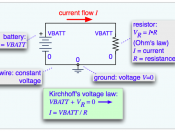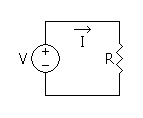ABSTRACT
Ohm's Law and Kirchhoff's rules is fundamental for the understanding of dc circuit. This experiment proves and show how these rules can be applied to so simple dc circuits.
INTRODUCTION
In the theory of Ohm's Law, voltage is simply proportional to current as illustrated in the proportionality, V=RI. As shown in this relation, V represent voltage which is the potential difference across the two ends of a electrical conductor and between which an electric current, I, will flow. The constant, R, is called the conductor's resistance. Thus by the Ohm's Law, one can determine the resistance R in a DC circuit without measuring it directly provided that the remaining variable V and I is known.
A resistor is a piece of electric conductor which obeys Ohm's Law and has been designed to have a specific value for its resistance. As an extension of the Ohm's Law, two more relationship can be drawn for electric circuits containing resistors connected in series or/and parallel.
For resistors connected in series, the sum of their resistance is, RTOTAL=R1+R2+ ..... +Rn . And for resistors connected in parallel, 1/RTOTAL==1/R1+1/R2+ ..... +1/Rn . Complex dc circuit involving a combination of parallel and series resistors can be analyzed to find the current and voltage at each point of the circuit using 2 basic rules formulated by Kirchhoff. 1) The algebraic sum of current at any branch point in a circuit is zero. 2) The algebraic sum of potential difference, V, around any closed loop in a circuit is zero. These rules and equations provided by the Ohm's law and the Kirchhoff rule can be experimentally tested with the apparatus available in the lab
EXPERIMENTAL METHOD
The apparatus used in the experiment includes a Voltmeter, an Ammeter, some connecting wires and a series of resistors and light...


